- Title: The Next Great Exoplanet Hunt
- Authors: Kevin Heng and Joshua Winn
- First Author’s Institution: University of Bern
- Published in American Scientist
How do you answer when the theorist frowns and says: “Exoplanetary science isn’t fundamental, it’s just applied physics—no offense, of course”. Your reply might be: “None taken Dr. X, yes, we are not expecting to gain insights into grand unified theories by hunting for exoplanets, but the stakes are nevertheless high. We are on the verge of the Copernican revolution all over again: we could find signs of life out there, however small, removing humanity from the center of the biological Universe. Are you with us?”
Indeed, the stakes are high, and the hunt is on. For the last three decades there has been a rush of activity to find exoplanets. We have found many. The most successful method to date is the transit method. Kepler, the most successful transit mission to date, has confirmed the existence of over 1000 exoplanets, two thirds of currently known planets.
According to Heng & Winn, the authors of today’s paper, the long-term strategy of exoplanet hunting is clear. First you find them. Second, you characterize them. Third, you search for biomarkers in their atmospheres. The first two steps both have a number of maturing methods, but we are still finding our footing with the third step. In this paper Heng & Winn largely focus on transiting planets—planets whose atmospheres we can study for biomarkers. Why? Read on.
Space-based transits versus ground based?
Initially, exoplanet transits were studied by ground based observatories. They have problems: the Sun is periodically in the way (usually during the day), and Earth’s atmosphere interferes with the observations. These problems can be circumvented by launching telescopes into space, see figure below. In space, the precision is only limited by fundamental photon counting noise; we can’t ask for anything better. Granted, launching things into space is expensive, but is getting cheaper through help from the private sector. Notwithstanding, ground-based surveys will still most likely continue to give you the most bang for your buck, and will continue to play a strong complementary role to space based transit missions in the future.
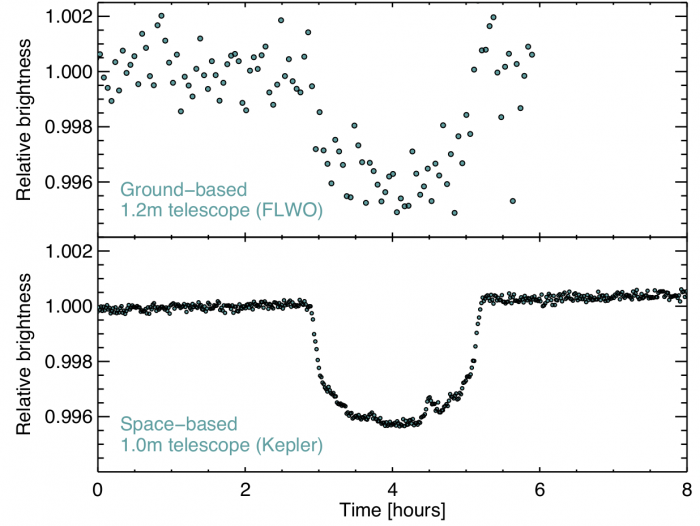
Figure 1: Precision in space is better. The upper panel shows a planetary transit observed from the ground with a 1.2m diameter telescope, while the lower panel shows a transit observed with Kepler (1.0m). The precision in space is higher: we don’t have to deal with the atmosphere, and our measurements are not interrupted periodically with the Sun rising every day. Figure 1 from the paper.
Characterizing exoplanetary atmospheres
The atmospheres of transiting planets can be studied and analyzed for biomarkers via transit spectroscopy. There are two main ways. First, during a transit, some of the starlight can shine through the atmosphere of the planet. We can then look for atmospheric absorption features, by contrasting the observed spectrum while transiting, and while not. The second way is to study occultations. The planet itself reflects light from it’s host star, which contains information about its atmospheric structure. We can infer how much light is reflected by detecting the drop in brightness as the planet travels behind the star.
However, not all exoplanets are created equal for atmospheric characterization. This characterization is easiest for Hot Jupiters, big Jupiter-size planets that orbit close to their host star, which tend to have puffy atmospheres. Heng & Winn note a stark contrast between the impressive sounding 1500 confirmed exoplanets, and the relatively small number of exoplanets we can currently meaningfully characterize the atmospheres of: only about a dozen (take a look at Figure 2). Most of them are hot gas giants, flaming puffy planets significantly larger than the Earth: not habitable. We want to change that, and go for the gold: habitable planets.
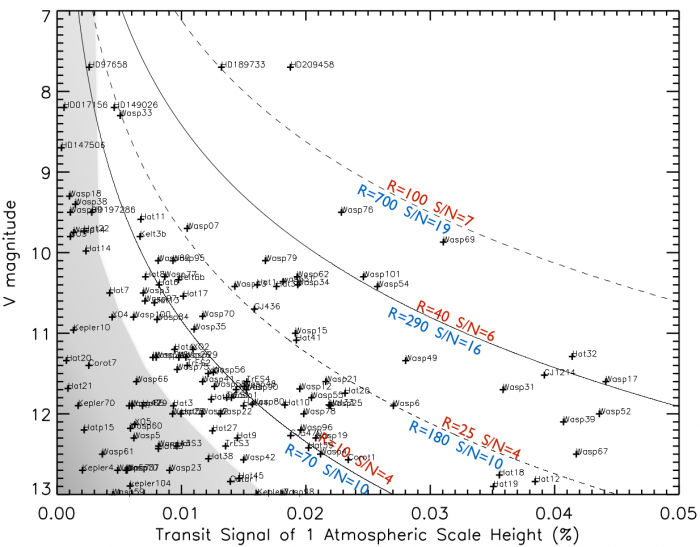
Figure 2: Exoplanetary atmospheres are hard to study. The diagram shows stellar V magnitude, or brightness, versus the strength of a planetary transit signal at 1 atmospheric scale height, a measure of how easy it is to characterize an exoplanet’s atmosphere. The easiest atmospheres are to the upper right; the hardest to the lower left. The curves show where Hubble (red), and JWST (blue) can obtain a spectrum with resolution R, and a signal-to-noise-ratio of S/N. We see that JWST will enable us to probe a lot more atmospheres! Figure 2 from the paper.
Planned Transit-Hunting Machines: Finders, and Characterizers
According to Heng & Winn, the path to finding habitable planets is clear. We need to detect Earth sized planets around the nearest, and brightest stars. These are the systems that maximize the atmospheric signal-to-noise ratio. We could then proceed to search for biosignatures with enough statistics to robustly probe for signs of life. This, however, requires new telescopes to first find them, and then characterize them. What is planned?
First are the transit-finders. Kepler changed the game, but left most of the sky relatively unexplored. Its success has inspired a fleet of transit-hunting successors, space missions along with complimentary efforts on the ground. Like Heng & Winn, we will focus here on the space missions, some of which are contrasted in the figure below. NASA’s TESS mission is scheduled to be launched in 2017, and will scan the entire sky in a systematic manner, specializing in finding nearby short period planets. Conversely, the European CHEOPS mission, also scheduled to fly in 2017, focuses on studying transits, one star at a time. Later on, in 2024, the PLATO mission is the most ambitious of all. It will borrow hunting strategies from Kepler, TESS and CHEOPS, and aims to build a catalog of true Earth analogs: Earth-like exoplanets orbiting within the habitable zones of Sun-like stars.
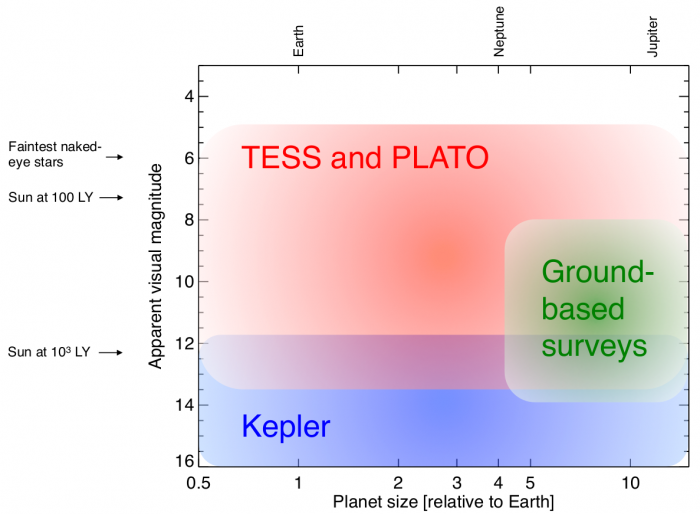
Figure 3: The sensitivity of transit-hunters Space based missions, like Kepler, TESS, and PLATO, are sensitive to a wide range of exoplanet sizes, while current ground-based surveys can only find the larger sized planets. TESS and PLATO specialize in finding planets all over the the sky, while the original Kepler mission stared deeper and fainter at a single field of view. Orbital periods are not shown in this diagram. LY means one light year. Figure 3 from the paper.
Then there are the atmospheric-characterizers. These are the big telescopes that will focus on recording transmission spectra during planetary transits. This will largely fall into the hands of the much anticipated JWST space telescope, and the upcoming extremely large ground based telescopes. Ideally, before these expensive shared-time observatories come online, we would want to have compiled a list of our best candidates: our top 10 sexiest transiting planets. Let’s get cracking!

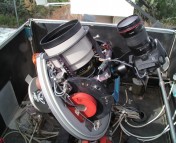

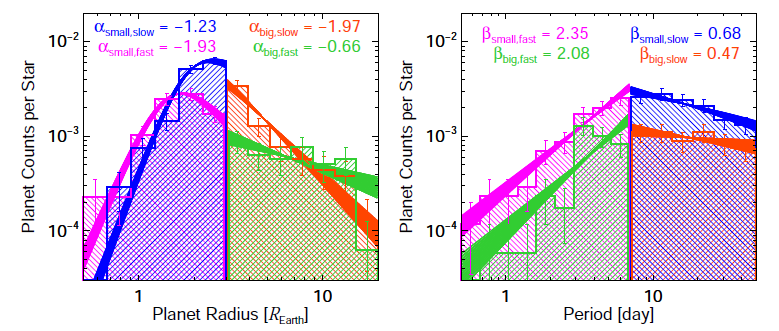
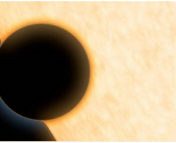
Dear Gudmundur Stefansson,
Wonderful piece and intriguing. I am not a scientist nor college educated but I do love science and possibility of science fiction becoming reality, and anytime I can read a paper that explains and informs and then invites an opinion, then I would have to try some science fiction venturing.
I know that earth is a unique and beautifully made planet that, going religious here, God made without everything we need to survive and even — to study. What we have here may incredibly be found out there on other planets.
Take Mars: red, thin atmosphere, cold because further away from the Sun. Now, Earth: blue. Atmosphere?– yes, and like Mars-the tops of mountains and some areas in the southern poles the atmosphere is thin. Cold?–our winters and mountains covered with snow, and below caves – moist and cold or cool.
Everything we have here can be applied to anywhere in the Universe. So, I believe our Earth is also hidden and because of the synchronization of orbits, it may be that when were are at a certain point in space in our orbit we are hidden to any Exoplanet and vice-versa.
The only way may be to put in space a telescope that is not maintained around our orbit but fixed outside Earth’s orbit, in this manner when we are passed a certain point the hidden exoplanets will come into their regular orbits and be seen by the telescope. For this to work, I believe we may have control the telescope from, again, outside of Earth itself but from various satellites orbiting and making checks each time and relaying those check-in’s to all the satellites and back to Earth.
May be a farfetched silly theory but science fiction has a way of sneaking into a comfortable reality, I like to think.
Good luck!
I remain,
Sincerely,
Norma Iris Montalvo (b 1955)
Correction to Comment:
Dear Gudmundur Stefansson,
Wonderful piece and intriguing. I am not a scientist nor college educated but I do love science and the possibility of science fiction becoming reality, and anytime I can read a paper that explains and informs and then invites an opinion, then I would have to try some science fiction venturing.
I know that earth is a unique and beautifully made planet that, going religious here, God made -with- everything we need to survive and even — to study. What we have here may incredibly be found out there on other planets but in bits and pieces.
Take Mars: red, thin atmosphere, cold because further away from the Sun. Now, Earth: blue. Atmosphere?– yes, and like Mars-the tops of mountains and some areas in the southern poles the atmosphere is thin. Cold?–our winters and mountains covered with snow, and below caves – moist and cold or cool.
Everything we have here can be applied to anywhere in the Universe. So, I believe our Earth is also hidden and because of the synchronization of orbits, it may be that when we are at a certain point in space in our orbit we are hidden to any Exoplanet, and vice-versa.
The only way we may find an Exoplanet may be to put in space a telescope that is not maintained around our orbit but fixed outside Earth’s orbit. In this manner when we are passed a certain point in our orbit the hidden exoplanets will come into their regular orbits and be seen by the telescope. For this to work, I believe we may have to control the telescope from, again, outside of Earth itself but also from various satellites orbiting in their fixed orbits outside of Earth and making checks each time and relaying those check-in’s to all the satellites and back to Earth.
May be a farfetched silly theory but science fiction has a way of sneaking into a comfortable reality, I like to think.
Good luck!
I remain,
Sincerely,
Norma Iris Montalvo (b 1955)
I found your comment interesting. Religion aside, the continued creation of new planets and the destruction of entire galaxies via stars going supernova, the constantly changing universe is incredibly and humbly. Images captured by the Hubble telescope is giving mankind a small glimpse into the universe. Please email me so we can continue this discussion.